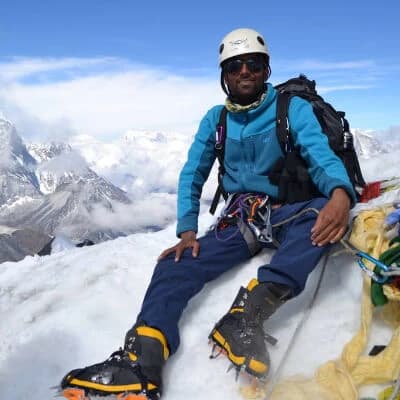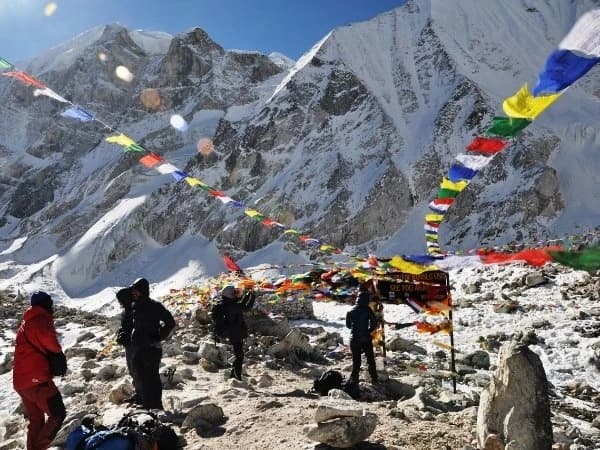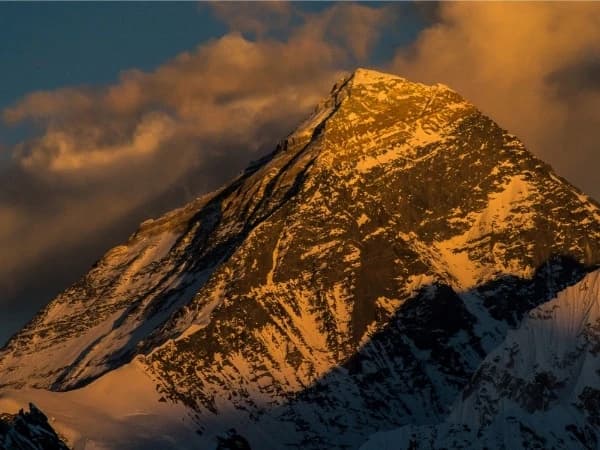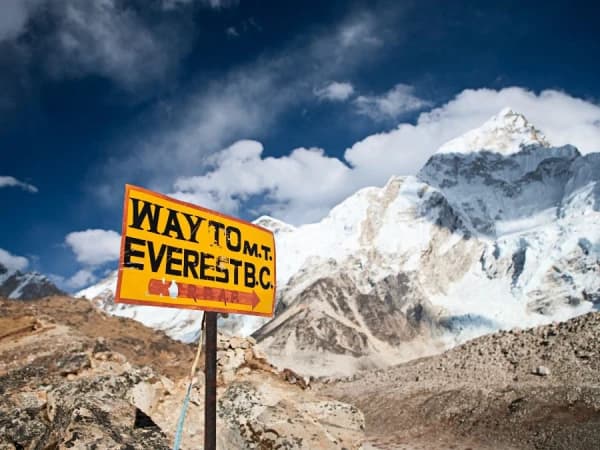Where is Annapurna Located?
Mount Annapurna is located in the north-central part of Nepal. Annapurna is in Gandaki province,forming a part of the majestic Annapurna Massif, a subrange of the Himalayas. The Annapurna Massif includes several towering peaks, with Mount Annapurna l being highest at 8,019 meters (26,545 feet ).
This mountain peak hold which holds the distinction of being the 10th highest mountain in the world. People curious about this world-renowned peak often ask, “where is mount Annapurna?” or “where is Annapurna located?” and the answer lies deep within the rugged terrain Himalayan Mountain Belt of Nepal.
Annapurna Massif stretches between the Kali Gandaki River to the west and the Marsyangdi River to the east. The range forms a circular mountain system that encloses the Annapurna Sanctuary.
Annapurna Sanctuary is known as the home to the most popular Annapurna Base Camp. The coordinates for Mount Annapurna I are approximately 28.5959°N, 83. 8203° E. Mount Annapurna lies about 40 km (25 miles) north of Pokhara city. Pokhara is a vibrant lakeside city, also the main gateway to the Annapurna Region.
Besisahar, Tatopani and Jomsom are some other nearby towns and cities. These Himalayan towns serve as access points for the various trekking routes. From Pokhara, if the day is clear and the weather is nice, trekkers and travellers can catch distant stunning views of the Annapurna Range.
So if you are wondering about where Annapurna is, or where Mountain Annapurna is located, then now you should know it's located in the heart of Nepal. It is commanding with a towering presence and natural beauty. Mount Annapurna Region is not only what many climbers dream of, but it is also a spiritual and cultural centerpiece of this Himalayan country.

Is Annapurna in the Himalayas?
As it's normal to get thoughts like “Is Annapurna in Himalayas then the answer is a big Yes!!. Annapurna is located in the Himalayas, specifically within the Himalayan mountain system of north central Nepal. Annapurna Range is also recognized as Annapurna Massif, a significant subrange of the greater Himalayas stretching across five countries – Nepal, India, Bhutan, China (Tibet) and Pakistan.
Annapurna is not only a part of the Himalayas it also represents one of its most iconic and formidable sections. The Himalayas are the youngest and highest mountain ranges in the world. They were formed by the tectonic collision between the Indian and Eurasian plates.
The Annapurna Massif with the grand system stands out for its geological structure, extreme altitudes and deep cultural significance. The range expands approximately 55 kilometers and is bordered by the Kali Gandaki Gorge to the west and the Marsyangdi valley to the east. These two prominent landmarks define natural boundaries within the central Himalayas.
The Annapurna Massif consists of several major peaks, the most prominent Annapurna I, which reaches an elevation of 8,091 meters and this makes Annapurna I the 10 th highest mountain in the world and also the first 8000-meter peak ever successfully climbed, back in 1950. Alongside the massif are Annapurna II (7,937m), Annapurna III (7,555m), Annapurna IV(7,525m) and Annapurna South (7291m). Each of them form the same Himalayan system, but they all possess unique topographical characteristics.
Annapurna Region is mostly recommended for its accessibility and spiritual richness. The range houses sacred sites, remote high-altitude settlements and world-famous trekking routes such as the Annapurna Circuit Trek and Annapurna Base Camp Trek, which attract thousands of trekkers and mountaineers annually.
The Annapurna Range: Peaks and Significance
Annapurna Range, also known as Annapurna Massif, is one of the renowned mountain ranges in the Himalayas, situated in North-Central Nepal. A stunning stretch of peaks dominates the skyline above the Gandaki province. It forms a dramatic part of the greater Himalaya mountain system. The massif spans approximately 55 kilometers and features multiple towering summits that are capable of attracting both climbers and trekkers from around the world.
The region is also home to Gangapurna, Hiunchuli and Machhapuchhre (Fishtail), the latter of which is sacred and off-limits to climbers. Beyond its physical grandeur, the Annapurna range holds very deep cultural and spiritual importance in Nepal. The word Annapurna translates to ‘Goddess of Nourishment’ in Sanskrit and according to Hindu tradition, Annapurna is revered as a deity of abundance and food.
Local communities around there believe the mountains to be sacred and most of the traditional ceremonies are often performed to honour the mountains. Annapurna Region is also a global trekking hotspot. Annapurna Base Camp (ABC) Trek and the Annapurna Circuit are two of the most iconic and amazing multi-day treks in the world.
These routes offer you breathtaking views of the Annapurna Massif. You can enjoy varied terrain from subtropical forest to alpine deserts. And beyond those, most travelers are immersed in the rich Gurung and Thakali cultures in that remote area.
At its core, the Annapurna Range represents a powerful blend of natural majesty, combining spiritual reverence, trekking adventure by making it one of the most treasured regions in the Himalayas.
Why Annapurna Is So Dangerous?
While discussing the most treacherous mountains around the world, Mountain Annapurna is frequently at the top of the list. Despite not being the tallest one, it has earned a reputation for extreme danger among the climbers. But Why is Annapurna so dangerous? Ahh! the answer lies in the combination factor that makes submitting Annapurna I one of the most riskiest undertakings in high-altitude mountaineering.
First and foremost, Annapurna I has historically maintained one of the highest fatality-to-summit ratios among all 8,000-meter peaks. Before advancements in equipment and forecasting, more than one out of every three climbers who attempted to summit didn't return back. Safety has improved slightly in the recent five or six decades, but still risk remains alarmingly high compared to other major peaks like Everest.
The primary danger is extremely unstable weather in the Annapurna Region. In this north-central Himalayan zone, storms can appear suddenly bringing whiteouts, sub-zero temperatures, and violent winds which strand or disorient climbers. The mountain is notorious for frequent and unpredictable avalanches; many of these occur on popular ascent routes. Natural hazards like this have claimed numerous lives and make route planning incredibly difficult.
Adding to the danger is the technical nature of the climb itself.Annapurna's steep faces, fragile ice cliffs, and unstable snowpack require advanced alpine skills. There are few safe zones to take rest and recovery and the descent is considered even more perilous than the ascent. During the rescue operations, many difficulties are faced. It doesn't show up on time, often delayed due to the remoteness
Compared to Mount Everest, it has benefits from fixed ropes, commercial expeditions and a well-trodden path. But the Annapurna still remains a raw and wild challenge compared to K2, another deadly peak. Still, Annapurna's avalanche-prone terrain arguably always makes it more unpredictable.
Climbers like Reinhold Messner and Ueli Steck have remarked on Annapurna's unique risk. Steck, who made a solo ascent in 2013 and described it as “the most dangerous thing” he had ever done in the mountains.
In short, the question “why Annapurna is so dangerous” concludes as a mix of volatile weather, technical difficulties, avalanche risk and remote terrain. This trail is a deadly combination demanding absolute respect and exceptional skill from all of the climbers who dare to climb the Annapurna Range.
Annapurna vs other Himalayan peaks
When talking about the Himalayan giants, names like Mount Everest, K2, Lhotse and Makalu often dominate the whole conversation. Somehow, Mount Annapurna l is less talked about in the mainstream. Hence, it holds a unique, fearsome reputation in the mountaineering world.
Not just its elevation that sets Annapurna I apart, but in actuality, it is a deadly combination of terrain, unpredictability, and danger that earns Annapurna both the respect and fear of even the most seasoned climbers.
|
Mountain
|
Elevation (m)
|
Fatality Rate (%)
|
Climb success
|
Notable Risk
|
|
Annapurna I
|
8,091
|
Around
32%(historically)
|
Very low
|
Avalanches, technical routes
|
|
Mount Everest
|
8,848.86
|
Around 1-2%
|
Very high
|
Altitude sickness, crowding
|
|
K2
|
8,611
|
25%
|
Low
|
Severe weather, technical ascent
|
|
Lhotse
|
8,516
|
Around 2.6%
|
Moderate
|
Technical sections, altitude
|
|
Makalu
|
8,485
|
9%
|
Low
|
Steep pitches, weather
|
Everest is the highest mountain in the world and is often perceived as accessible due to commercial expeditions, improved weather forecasting and established climbing infrastructure. At the same time, Annapurna I has no straightforward route to the summit; every ascent involves negotiating complex avalanches and rockfalls.
Likewise, the weather is notoriously unstable and snow accumulation well well-planned expenditure vulnerable to sudden disasters. Many climbers refer to Annapurna as “a climber's mountain,” which demands elite skill, mental endurance and readiness to face fatal risks.
Annapurna's fatality rate has historically hovered above 30% making it the most dangerous of all eight-thousanders. Even having modern gear and technology has improved survival odds, but mountains still need immense respect. Most of the climbers often say, “Annapurna, the mountain decides who returns back ”.

Why Fewer Climbers Attempt Annapurna?
Despite being the 10th highest peak in the world, far fewer people attempt Annapurna I while comparing it with Everest or even K2. According to, Himalayas database, there are only a few hundred successful summits of Annapurna I that have been recorded, while looking at the data of Everest summit has over 10,000 successfulascents.
Lower data number is not due to the “mountain's fatal reputation” because of higher Insurance cost, expedition narrow window, even professional climbers consider Annapurna a last frontier.
In conclusion, Annapurna's danger and raw challenge are both legendary and terrifying ”. It doesn't cater to commercial expeditions or tourists. This trail is for those who are fully prepared to risk everything. So, Annapurna continues to stand apart because of its unforgiving nature.
How to Visit or Trek Near Annapurna?
In Nepal,the Annapurna Region is one of the most rewarding trekking destinations. This is a beloved Himalayan section with dramatic mountain views, culturally rich villages, well well-established trails. The Annapurna region welcomes all seasoned trekkers and beginners. Are you wondering how to visit near Annapurna? Here is some essential information combining popular routes, permits, the best season and tips for beginner hikers.
The two most iconic treks of the Annapurna Region are the Annapurna Base Camp (ABC) and the Annapurna Circuit Trek.
Annapurna Base Camp (ABC) Trek
This trek is the most iconic and accessible moderately challenging trekking route. It is ideal for both beginner and experienced trekkers. The trail takes you deep into the Annapurna Sanctuary, which is a high glacial basin surrounded by peaks culminating at Annapurna Base Camp.
On the way, you will pass through charming Gurung and Magar villages, terraced farmlands, dense Rhododendron forest and also natural hot springs at Jhinu Dhada. This trek offers you a combination of spectacular views of Annapurna South, Hiunchuli, Machhapuchhre and Annapurna I itself.
The trek usually starts from Nayapul or Ghandruk. The Annapurna Base Camp trek mostly takes 7 to 12 days to complete the trek and the time also depends on choosing the route and pace. On this mainstream trail, you can find a well-established tea house along the way, which makes it perfect for all those looking to experience the grandeur of the breathtaking Himalayas without climbing.
Annapurna Circuit Trek
Annapurna Circuit Trek is considered one of the most scenic and diverse long-distance treks in the world, which circles the entire Annapurna Massif. To complete the full circuit, around 15 to 20 days is necessary. You need to cross diverse terrain, starting from subtropical forest, lush woodlands, to high-altitude desert and glacial debris.
It includes a dramatic crossing of Thorong La Pass ( 5,416 m ), one of the highest passes on Earth, which offers breathtaking views of the Himalayas. This trek usually starts from Besisahar and ends in Jomsom or Tatopani, or while using optional extensions to Poon Hill or Annapurna Base Camp. It takes a maximum of 15 to 20 days, depending on route and acclimatization schedule.
This iconic circuit trek passes through beautiful traditional villages, including those Gurung, Thakali and Manangi communities. Annapurna Circuit offers cultural immersion with natural beauty, a well-maintained treehouse and dramatic changes in scenery. This is the reason why the Annapurna Circuit trek is a bucket list adventure for serious trekkers.

Necessary Permits
To explore the diverse culture and terrain of the Annapurna region, whether it is the circuit route or the classical base camp journey, you will to obtain the following permits.
- ACAP ( Annapurna Conservation Area permit )
This ACAP permit helps you fund conservation efforts and also for sustainable tourism in the Annapurna Conservation Area. This permit is required for all the treks in the Annapurna Region.
- TIMS (Trekkers Information Management System) card
The TIMS card is managed by the Nepal Tourism Board. This card ensures the safety of trekkers or visitors by keeping track of their records. Most of the time, this TIMS card is used for the search and rescue operations in the Himalayas.
Both of these permits are available at the Nepal Tourism Board Office in Kathmandu or Pokhara. You will need a passport copy, passport-sized photo, visa copy and insurance document to apply for these permits. These permits are recommended to obtain before beginning your trek. These are mandatory essentials for all trekkers, no matter if it's a solo or guided trek.
Best Time to Visit Annapurna
Are you planning a trek to Annapurna Region? Then knowing the best time to visit Annapurna is very necessary for a safe and amazing experience. The most favourable trekking seasons are spring (March to May) and Autumn (September to November). These seasons offer you breathtaking, clear mountain views, clean skies, suitable weather and natural scenery.
Spring (March, April and May): If you are planning to visit in spring, then the trails are alive with blooming rhododendron forest, mild temperature and stable weather conditions. This time is one of the most amazing times to experience the Annapurna Base Camp and Annapurna Circuit Treks. Spring offers you clear skies and longer daylight hours to make perfect photographs and high-altitude hikes.
Autumn (September, October and November): The Autumn season is also considered as the peak trekking season in the Annapurna Region. You can enjoy the post-monsoon with a combo of clear blue skies, stunning views of Annapurna I and Machhapuchhre, which draws thousands of trekkers each year. This time the weather is cool and dry, an ideal for long circuit training without takingthe risk of heavy rainfall or snow.
Which Season Should Be Avoided?
For the trekking in these breathtaking routes, you should avoid the monsoon season (June to August). During this season, there will be high rainfall, you will have to face slippery trails and limited visibility. Similarly, you need to avoid the winter season (December to February) unless you're well-equipped for the snow and freezing cold conditions.
Tips for Beginners Trekkers
Trekking in the Annapurna Region is a great experience and it can be amazing with the right preparation. Even first-time trekkers can enjoy a journey to the Himalayas safely and confidentially. No matter whether you are planning for the Annapurna Circuit or the Annapurna Base Camp trek, here are some Essential Tip list which gonna help you to start
➔ Choose the Right Trek for Your Fitness Level
If you are a beginner, then for you the Annapurna Base Camp (ABC) Trek will be a great option. This is a shorter, less strenuous trek which offers stunning views of Annapurna I, Machhapuchhre and other surrounding peaks. The Annapurna Circuit is la onger and demanding trek that can be tackled with proper preparations.
➔ Train Before You Trek
Training is necessary to tackle the trek, so you should build leg strength and stamina by regular hikes, walking and cardio workouts at least a month in advance, which will help your body to handle long days of walking.
➔ Pack Smart but Light
You should only bring the essential gear, layered clothing, windproof jacket, great quality, comfortable trekking boots, water purification tools and other essentials. Packing right for the varying terrain and climatic conditions will help you secure a memorable and fun experience.
➔ Stay Hydrated
During high altitude trek, altitude sickness is a real concern. You should drink plenty of water and take a rest. No need to rush, as you know “slow and steady is key in the Himalayas ”.
➔ Hire a Guide or Porter
Still unsure about navigating trails or managing gear, then no problem you can consider hiring a licensed professional guide or Porter. These people will provide local insights, care for your safety and also help in the local economy.
➔ Get the Right Permits
As the trek is in the Himalayan range, all the trekkers must obtain the ACAP ( Annapurna Conservation Area permit) and TIMS Card before starting their journey. It is also crucial to be literate about rules and regulations en route.
➔ Respect Local Culture
The Annapurna Region is home to the rich Gurung and Thakali cultures.You should be respectful in the village. Always ask for permission before taking photos, videos and follow local customs.
FAQs About Annapurna
Where is Mount Annapurna located?
Mount Annapurna is located in north–central Nepal, within the Annapurna Massif of the Himalayan Mountain Range. It lies in Gandaki province, roughly 40 km north of Pokhara.
Is it safe to climb Annapurna?
Climbing Annapurna is extremely dangerous due to frequent avalanches, unstable terrain and unpredictable weather. Only experienced climbers with technical skills should attempt this expedition.
Can I see Annapurna from Pokhara?
Yes, of course, on a clear day, you can enjoy breathtaking views of the Annapurna Range, including Machhapuchhre (Fishtail) and Annapurna South from Pokhara.
How long is the Annapurna Circuit Trek?
Annapurna Circuit Trek typically takes 15 to 20 days, depending on the route. It covers 160 – 230 km, crossing diverse landscapes and reaching the high Thorong La Pass ( 5,416 m )

Conclusion: The Legacy and Location of Annapurna
The Annapurna Mountain is not only a towering geographical feature it also carries the symbol of Himalayan grandeur, spiritual reverence and an extreme adventure. As all those who wonder “where is Annapurna or where mountain Annapurna located, we got the answer that it is situated deep within North Central Nepal, in the heart of the Himalayas.
The centerpieces of the Annapurna region that continue to challenge, inspire and humble climbers. Whether you are a mountaineer, trekker, or cultural explorer. Annapurna offers something profound: beauty, danger and an unmatched sense of awe.
From the scenic views in Pokhara to the sacred peaks hidden within the Annapurna Sanctuary, this region exemplifies the power and mystery of the Himalayas, which holds much more than just geographical significance.
In essence, Annapurna is a destination where nature, culture and adventure meet. If you're planning to visit the Annapurna region, it will leave a lasting and amazing impression. It will be attached to your memories as one of the extraordinary places on earth.
“ Mountains are not stadiums where I satisfy my ambition; they are the cathedrals where I practice my religion.”
— Anatoli Boukreev
Legendary Himalayan climber









